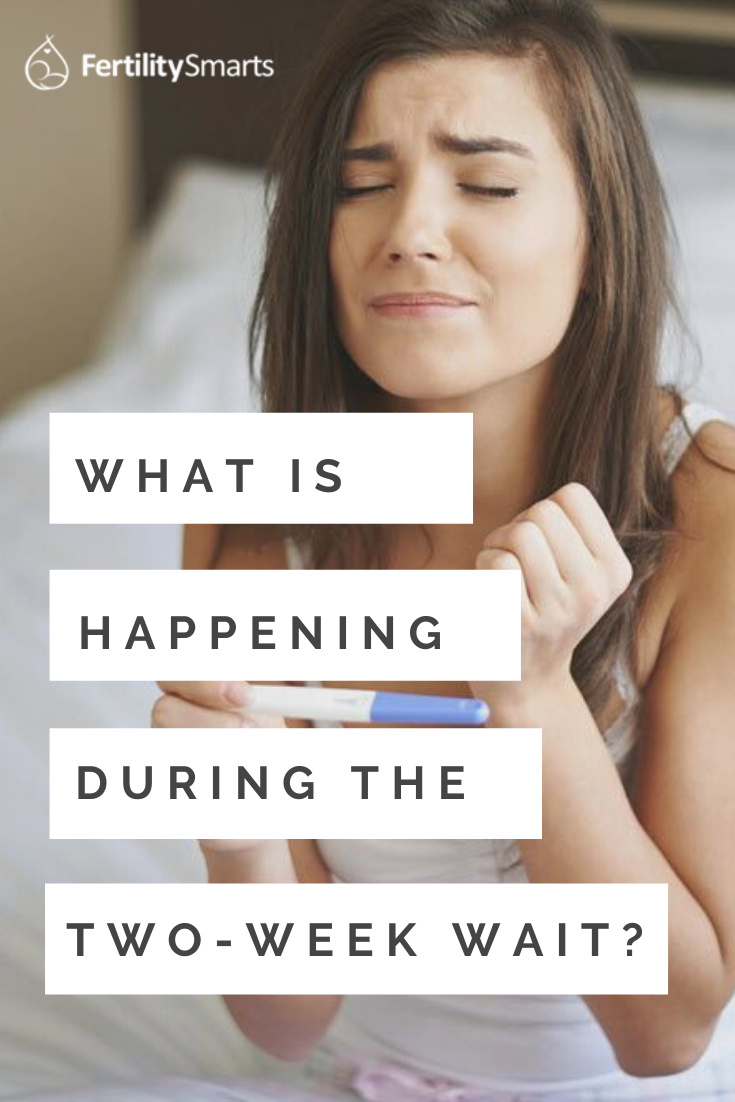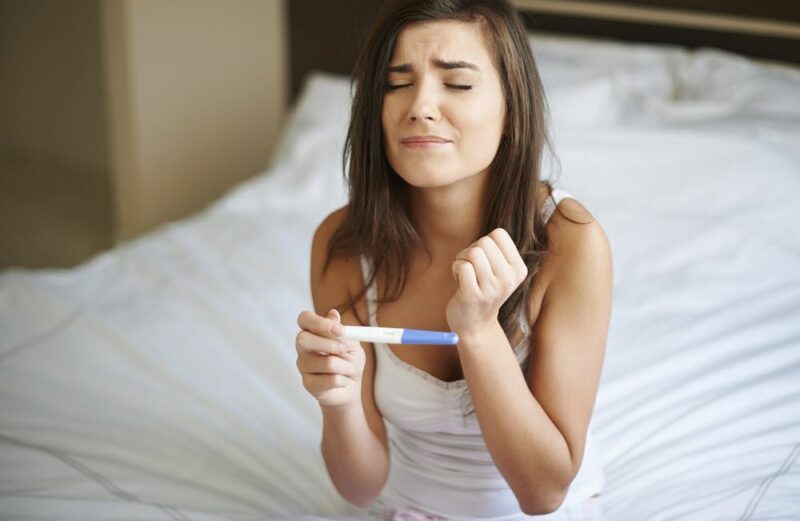
Source: Gpointstudio/Dreamstime.com
Implantation is a critical yet mysterious step when it comes to pregnancy.
If you are actively trying to conceive a baby or have had a fertility procedure like in vitro fertilization (IVF) or intrauterine insemination (IUI), the wait in between timed intercourse, insemination, or an embryo transfer, and the greatest accuracy of results on a home pregnancy test or a Beta hCG test is around two weeks.
Known as the two-week wait (2WW), this period can be filled with anxiety and uncertainty as the countdown to testing day progresses.
While we can’t help the days pass by any faster, we can give you an idea of what might be occurring if implantation is successful.
Keep in mind that the timeline is approximate, but here is a look at what could be happening inside. There are three charts depending on the approach to conception:
- Intercourse or intrauterine insemination (IUI)
- 3-day embryo transfer
- 5-day embryo transfer
In terms of the beginning steps of a successful pregnancy, this is what you might expect.
What happens after intercourse or IUI?
After intercourse or intrauterine insemination (where washed sperm is placed into the uterus), this is what the early stages of pregnancy may look like.
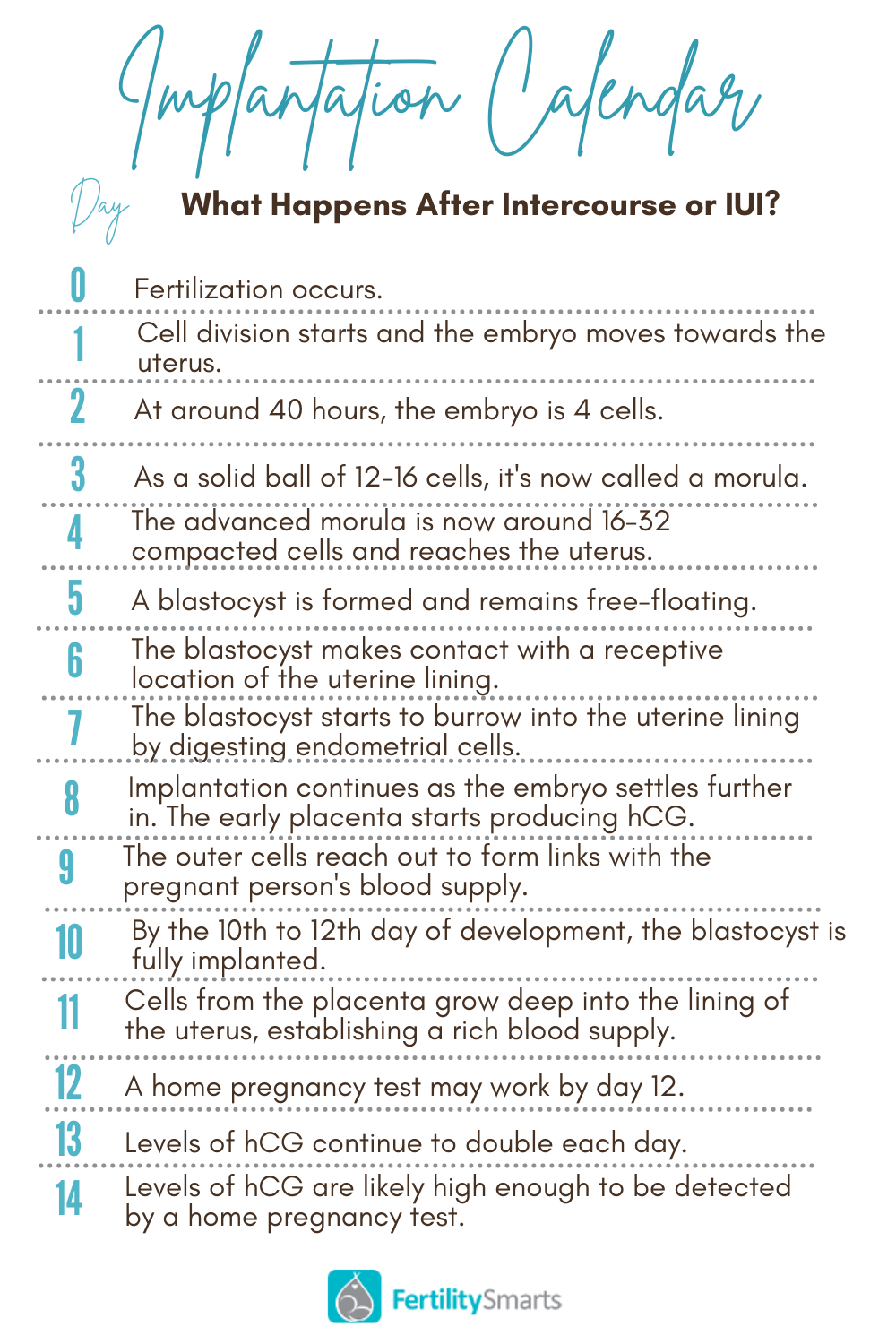
|
Ovulation occurs. An egg has been released from its follicle and is swept into the fallopian tube. (Read more about figuring out when you ovulate.)
In a typical ejaculation, millions of sperm are released, while only several hundred to a few thousand make the journey through the cervix and uterus and up to the fallopian tube. Egg meets sperm (typically within the fallopian tubes) approximately within 12-24 hours of ovulation.
In the case of IUI, washed sperm are delivered right into the uterus.
Typically, the 23 maternal and 23 paternal chromosomes split, intermingle and reform to one set of 46 chromosomes containing contributions from both the sperm and egg.
If the sperm has a Y chromosome, a male embryo will form; if the sperm has an X chromosome, a female embryo will form.
A fertilized egg is called a zygote.
|
|
Day 1: Cell division (also called cleavage) starts 24-30 hours after fertilization; the 2-cell stage can be expected around 30 hours after fertilization.
As cell division occurs, the embryo starts to move through the fallopian tube towards the uterus.
The embryo is encased in a protective coating called the zona pellucida that prevents it from sticking and implanting in the incorrect location.
|
|
Day 2: The cells, called blastomeres, continue to divide, becoming smaller with each cleavage division. 2 cells become 4 cells, become 8 cells. It takes around 40 hours to reach the 4-cell stage.
At around the 8-cell stage (around 60 hours), the cells start to loosely clump together. This process is known as compaction.
|
|
Day 3: Approximately 80 hours, while still in the fallopian tube, the embryo is a solid ball containing 12 to 16 cells called a morula, which takes its name from its mulberry-like appearance.
The embryo reaches the uterine cavity between the 3.5 to 4th day.
|
|
Day 4: The late-stage or advanced morula is now around 16 to 32 compacted cells.
Now in the uterus, at around 4.5 days, the morula starts to develop into an early blastocyst.
Characteristics of a blastocyst take shape; a fluid-filled inner cavity develops. The cells separate into an outer layer, the trophoblast (which becomes the placenta), and surround the inner cell mass, which becomes the embryo.
Around the end of the fourth day, the protective shell around the blastocyst, known as the zona pellucida, starts to dissolve. The embryo hatches from the protective structure in preparation for implantation.
|
|
Day 5: The blastocyst is formed and remains free-floating (unattached).
Around the end of the fifth day, the protective shell around the blastocyst, known as the zona pellucida, starts to dissolve. The embryo hatches from the protective structure in preparation for implantation.
The endometrial lining is getting ready, called proliferating, making crypts.
|
|
Day 6: The blastocyst makes contact with the uterine lining, known as apposition. This early phase of implantation starts at approximately days 5.5 – 6.5.
Interaction between the blastocyst and the uterine lining starts.
|
|
Day 7: The blastocyst starts to burrow into the uterine lining by digesting endometrial cells.
|
|
Day 8: The blastocyst is partially embedded in the uterine lining. The early placenta starts producing human chorionic gonadotropin (hCG).
This hormone can be identified in the blood and urine of a pregnant person as a positive pregnancy test as early as 8 to 9 days.
Earlier detection depends on the amount of hCG present and the sensitivity of the testing method. With a very sensitive detection method (most likely blood test), a pregnancy test can be positive at this stage.
Though hCG may be detected in the mother’s blood from day 8 onward, it is usually tested for about 2 weeks after the day of ovulation.
This is simply the earliest limit and unlikely for most people. Keep in mind that hCG doubles every 2-3 weeks during early pregnancy, and it needs time for the levels to build up.
|
|
Day 9: The blastocyst is more deeply embedded into the uterine lining. The outer cells reach out to form links with the mother’s blood supply. The inner cells form into two, and then later, into three layers. Each of these layers will grow to be different parts of the baby’s body.
|
|
Day 10: By the 10th to 12th day of development, the blastocyst is fully implanted.
|
|
Day 11: The embryo is surrounded by fluid inside the amniotic sac. It’s the outer layer of this sac that develops into the placenta. Cells from the placenta grow deep into the lining of the uterus, establishing a rich blood supply. This ensures the baby receives all the oxygen and nutrients it needs.
|
|
Day 12: Changes known as the decidua reaction are evident in the area immediately surrounding the implantation location and can sometimes be visualized through ultrasound.
Home pregnancy tests may be good between 12-14 days after ovulation. As the placenta develops and releases increasing quantities of hCG hormone, the chances of the pregnancy test detecting pregnancy get better.
|
|
Day 13: Levels of hCG continue to increase.
|
|
Day 14: Levels of hCG should now be high enough to be detected by a home pregnancy test. A negative home pregnancy test is not always reliable, and a blood test for hCG is more reliable.
|
|
Days 22-28 The heart has its basic form and now starts beating. This can be seen on an ultrasound examination.
|
What Happens After a 3-Day Embryo Transfer?
After embryos are grown in the laboratory, they can be transferred into the uterine cavity on either day 3 or 5 of embryo growth. Here is a look at what could be happening inside the lab and your body with each day post-3-day transfer (DP3DT).
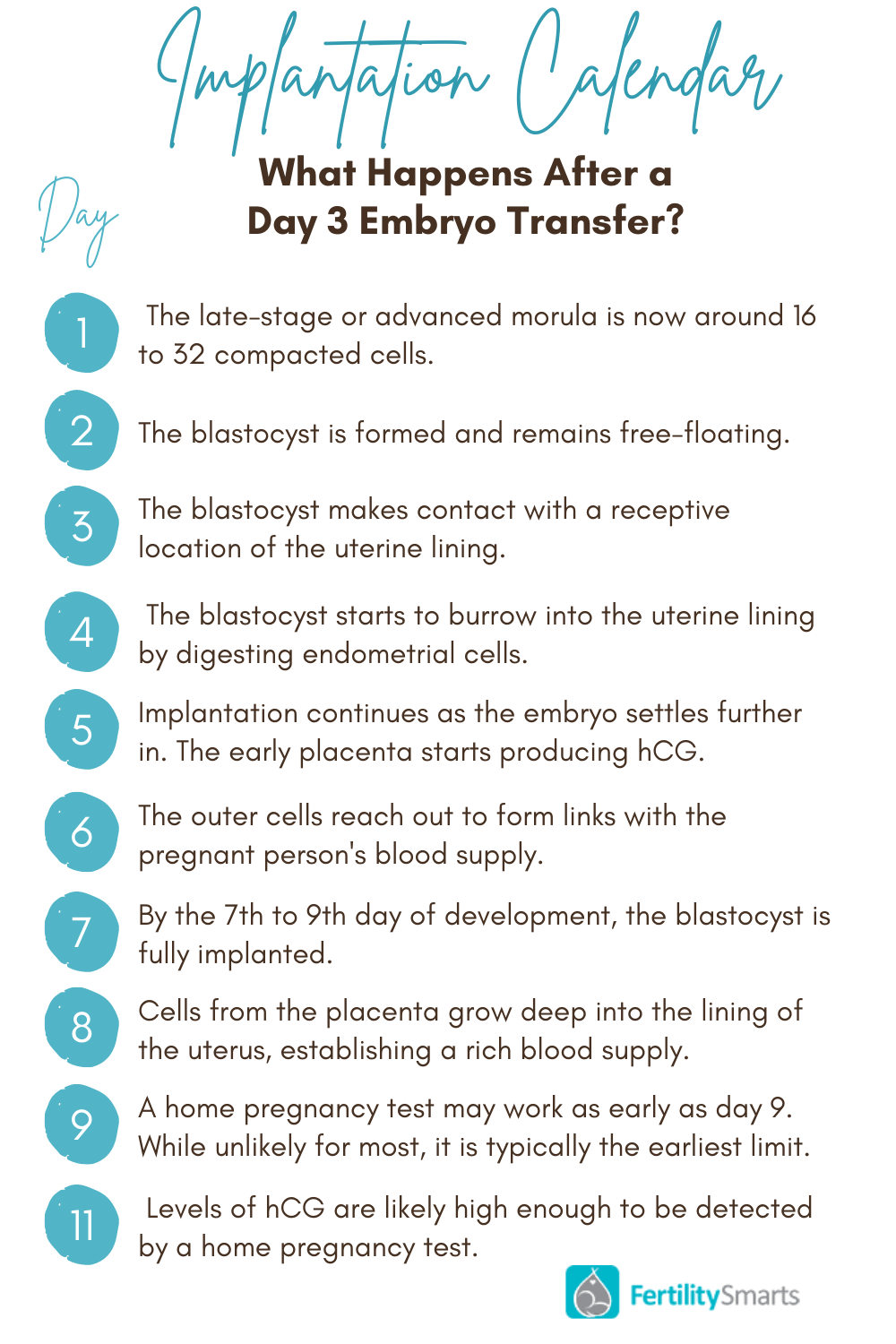
|
Day 1: The late-stage or advanced morula is now around 16 to 32 compacted cells called a morula, which takes its name from its mulberry-like appearance.
Once transferred to the uterine cavity, at around 1.5 days, the morula starts to develop into an early blastocyst.
Characteristics of a blastocyst take shape: a fluid-filled inner cavity develops, and the cells separate into an outer layer, the trophoblast (which becomes the placenta), and surrounds the inner cell mass, which becomes the embryo.
|
|
Day 2: The blastocyst is formed and remains free-floating (unattached).
The protective shell around the blastocyst, known as the zona pellucida, starts to dissolve in preparation for implantation.
The endometrial lining is getting ready, called proliferating, making crypts.
|
|
Day 3: The blastocyst makes contact with a receptive location of the uterine lining, known as apposition. This early phase of implantation starts at approximately day 2.5 – 3.5.
Interaction between the blastocyst and the uterine lining starts.
|
|
Day 4: The blastocyst starts to burrow into the uterine lining by digesting endometrial cells.
|
|
Day 5: Implantation continues as the embryo settles further in. The early placenta starts producing human chorionic gonadotropin (hCG) hormone.
The early placenta starts producing human chorionic gonadotropin (hCG). This hormone can be identified in the blood and urine of a pregnant person as a positive pregnancy test as early as 8 to 9 days.
Earlier detection depends on the amount of hCG present and the sensitivity of the testing method. With a very sensitive detection method (most likely blood test), a pregnancy test can be positive at this stage.
This is simply the earliest limit and unlikely for most people. Keep in mind that hCG doubles every 2-3 weeks during early pregnancy, and it needs time for the levels to build up.
|
|
Day 6: The blastocyst is more deeply embedded into the uterine lining. The outer cells reach out to form links with the mother’s blood supply. The inner cells form into two, and then later, into three layers. Each of these layers will grow to be different parts of the baby’s body.
|
|
Day 7: As the placenta develops and releases increasing quantities of hCG hormone, the chances of a home pregnancy test detecting pregnancy get better.
By the 7th to 9th day of development, the blastocyst is fully implanted.
|
|
Day 8: The embryo is surrounded by fluid inside the amniotic sac. It’s the outer layer of this sac that develops into the placenta. Cells from the placenta grow deep into the lining of the uterus, establishing a rich blood supply. This ensures the baby receives all the oxygen and nutrients it needs.
|
|
Day 9: Changes known as the decidua reaction are evident in the area immediately surrounding the implantation location and can sometimes be visualized through ultrasound.
A home pregnancy test may work as early as day 9. As the placenta develops and releases increasing quantities of hCG hormone, the chances of the pregnancy test detecting pregnancy get better.
This is simply the earliest limit and unlikely for most people. Keep in mind that hCG doubles every 2 days during early pregnancy, and it needs time for the levels to build up.
|
|
Day 10: Levels of hCG continue to increase.
|
|
Day 11: Levels of hCG should now be high enough to be detected by a home pregnancy test. However, a negative home pregnancy test is not always reliable, and a blood test for hCG is more reliable.
|
What Happens After a 5-Day Embryo Transfer?
After embryos are grown in the laboratory, they can be transferred into the uterine cavity on either day 3 or 5 of embryo growth. Here is a look at what could be happening inside the lab and your body with each day post-5-day transfer DP5DT.
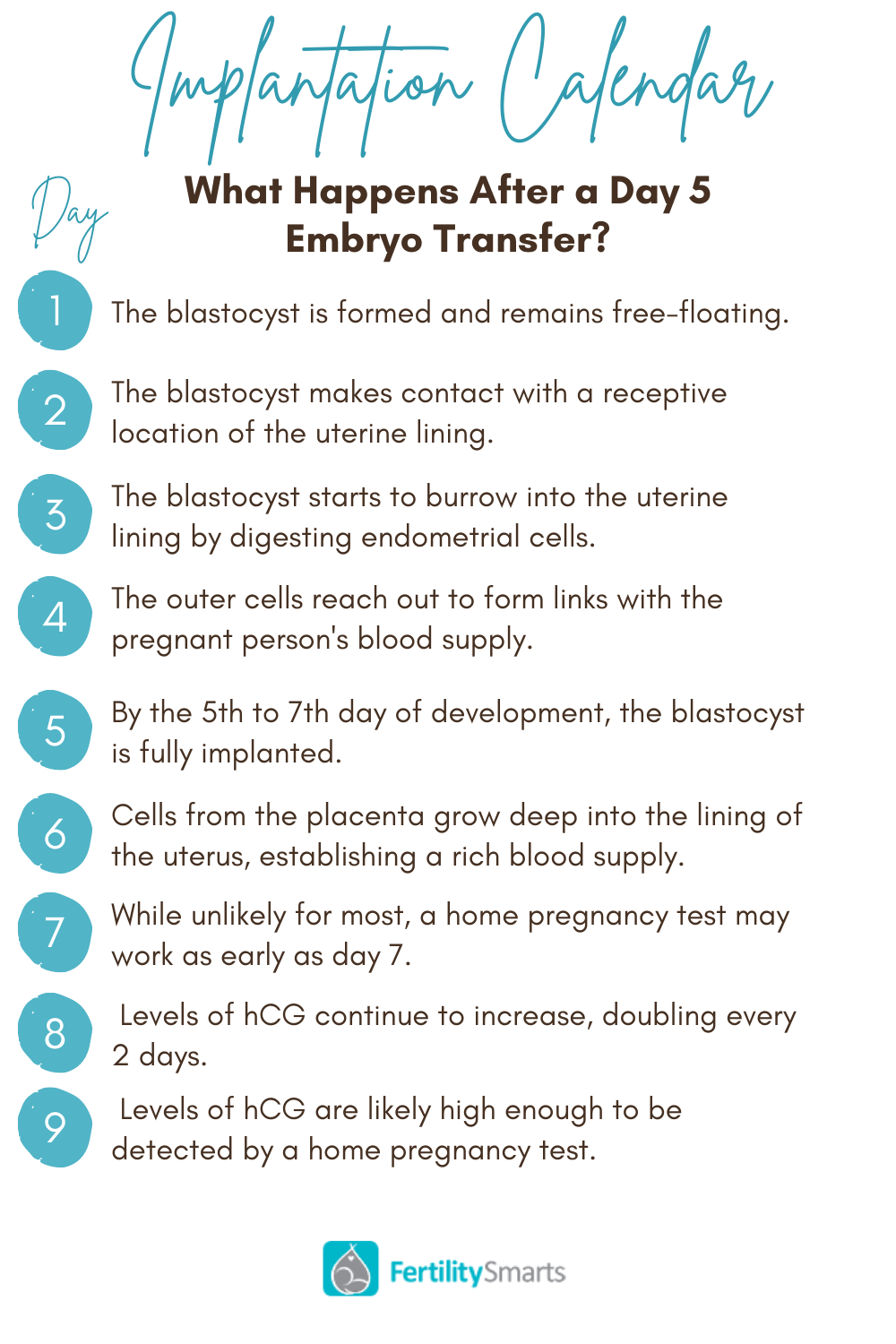
|
Day 1: Once transferred to the uterine cavity, the blastocyst remains free-floating and gets nutrition from the reserves of the egg and the fluid in the maternal cavity.
If it hasn’t already, the expansion of the cells and the fluid-filled cavity within the blastocyst causes a break in the hard outer shell called the zona pellucida, and the embryo “hatches” out.
|
|
Day 2: This blastocyst makes contact with the endometrium (uterine lining) and attaches to a receptive location on the surface of the uterine lining.
|
|
Day 3: The blastocyst starts to burrow into the endometrium, initiating implantation. This is also called adhesion and means there is increased “interaction” between the blastocyst and the uterine lining.
|
|
Day 4: Implantation continues as the embryo settles further in. The blastocyst is more deeply embedded into the uterine lining. The outer cells reach out to form links with the mother’s blood supply. The inner cells form into two, and then later, into three layers. Each of these layers will grow to be different parts of the baby’s body.
|
|
Day 5: By the 5th to 7th day post-transfer, implantation is complete. The blastocyst is fully implanted.
|
|
Day 6: The embryo is surrounded by fluid inside the amniotic sac. It’s the outer layer of this sac that develops into the placenta. Cells from the placenta grow deep into the lining of the uterus, establishing a rich blood supply. This ensures the baby receives all the oxygen and nutrients it needs.
|
|
Day 7: As the placenta develops and releases increasing quantities of hCG hormone, the chances of a home pregnancy test detecting pregnancy get better.
Though hCG may be detected in the mother’s blood from day 7 onward, it is usually tested for about 2 weeks after the day of transfer.
Earlier detection depends on the amount of hCG present and the sensitivity of the testing method. With a very sensitive detection method (most likely a blood test), a pregnancy test can be positive at this stage.
This is simply the earliest limit and unlikely for most people. Keep in mind that hCG doubles every 2 days during early pregnancy, and it needs time for the levels to build up.
|
|
Day 8: Levels of hCG continue to increase.
|
|
Day 9: The levels of the hormone hCG are high enough to be detected even by a home pregnancy test. However, a negative home pregnancy test is not always reliable, and a blood test for hCG is more reliable.
Changes known as the decidua reaction are evident in the area immediately surrounding the implantation location and can sometimes be visualized through ultrasound.
|
Read 5 Things Your Embryologist Wants You to Know About Your IVF Procedure
Read: Books About Infertility
Read: What Are Your Options for Your Remaining Embryos?
